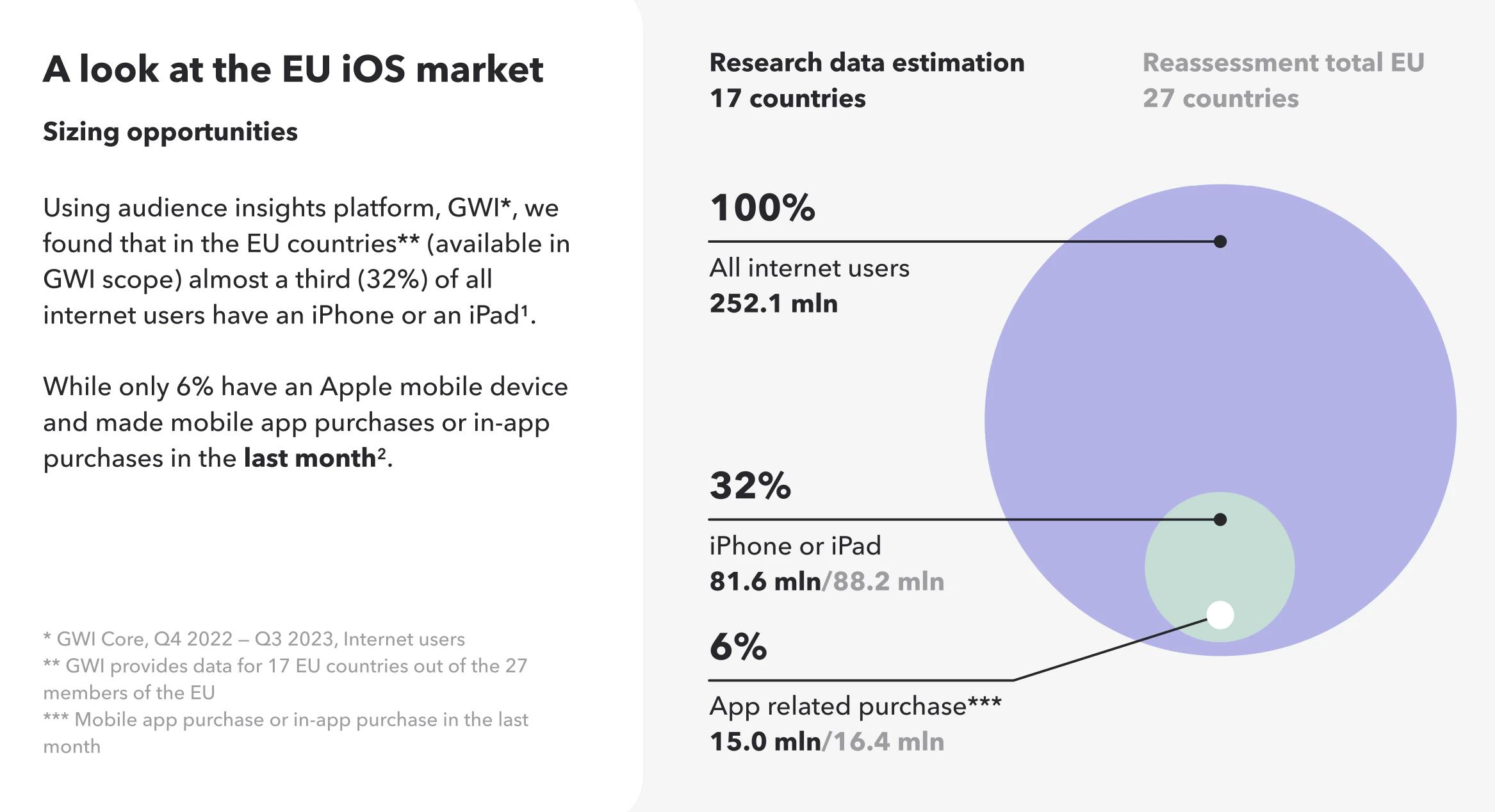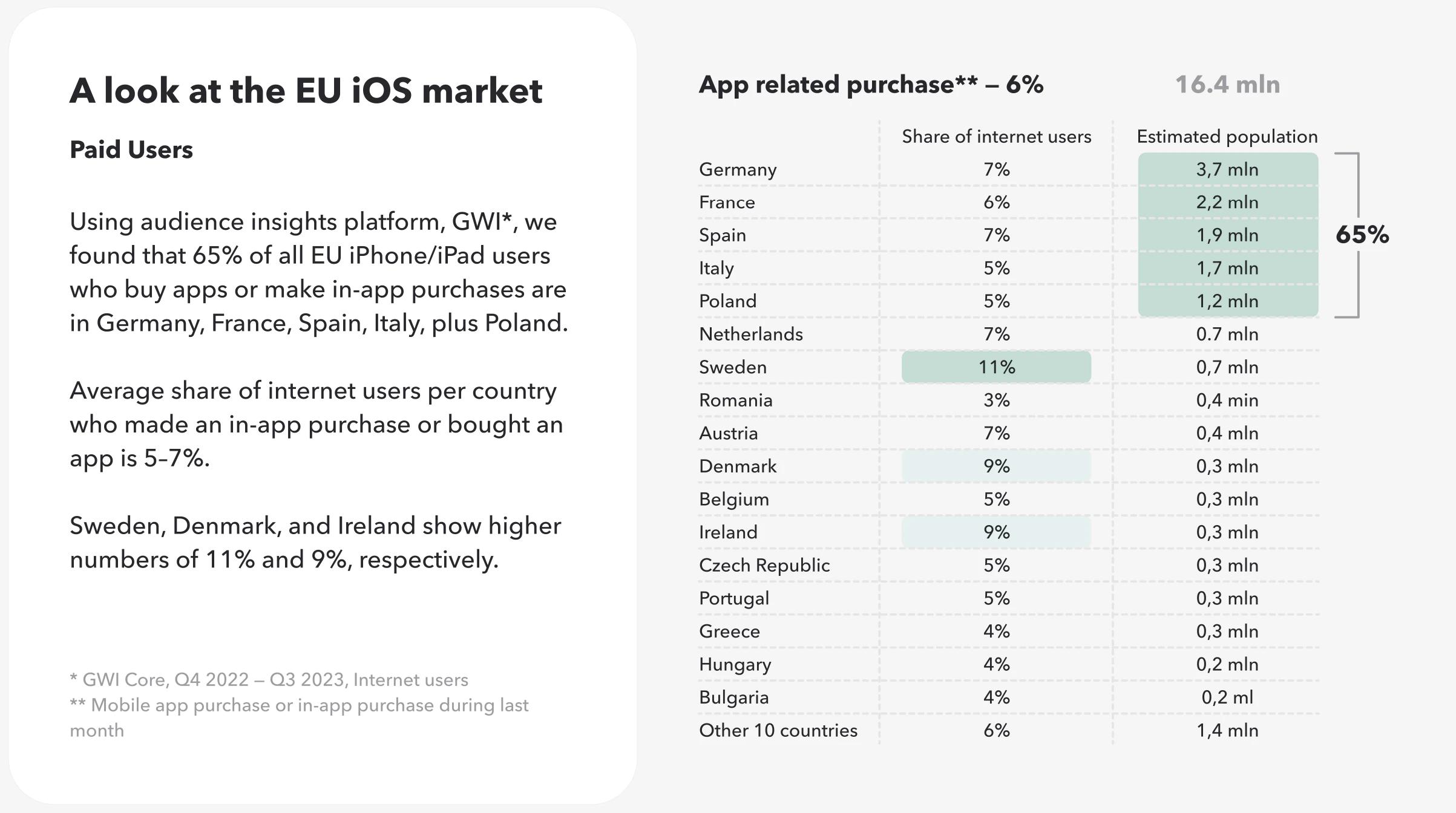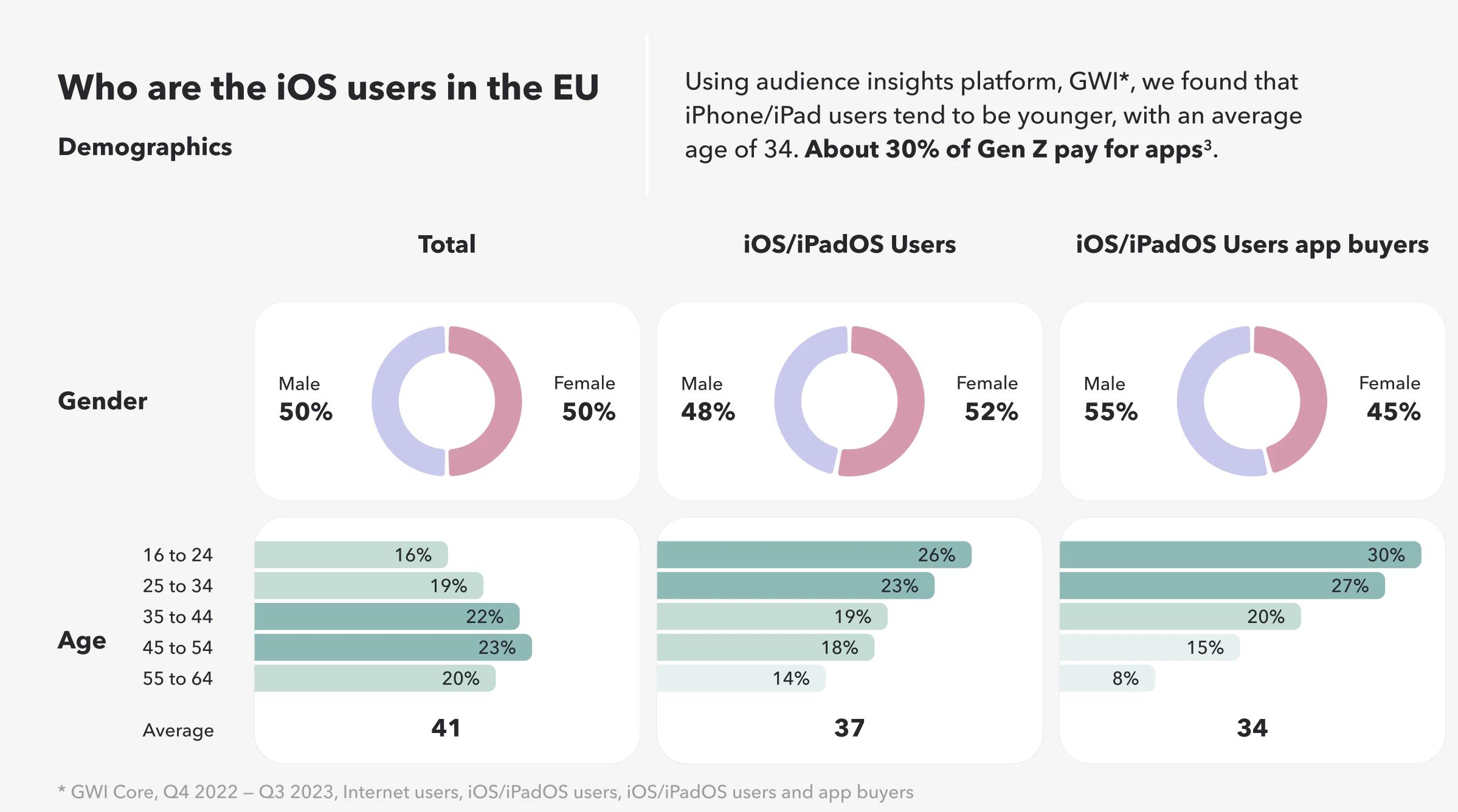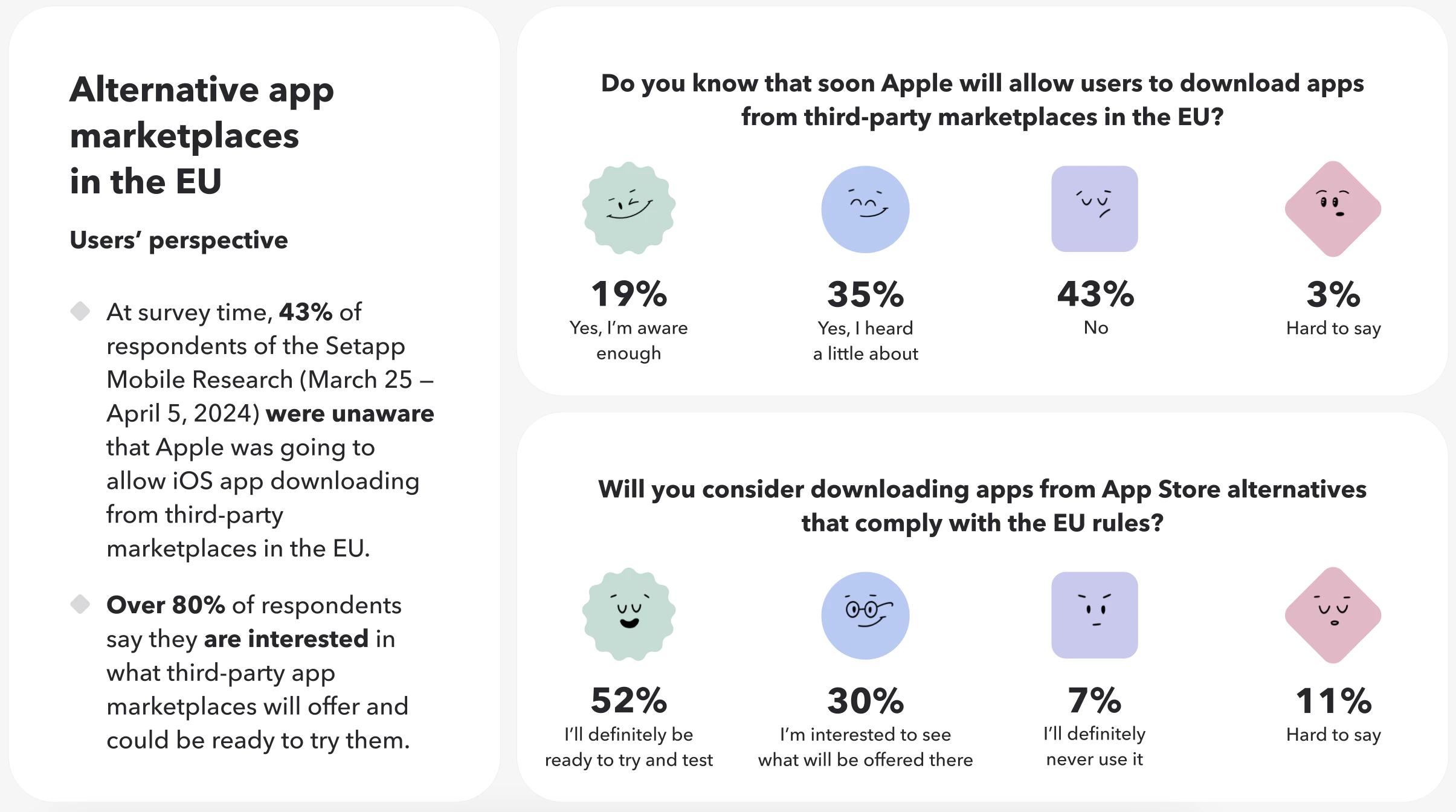What I learned as an Australian indie developer adapting my apps for the EU market and trends
Michael Tigas is an Australian mobile app developer focused on creating apps for startups and small businesses. He recently joined Setapp Mobile, an alternative iOS app marketplace in the EU that gathers selected productivity and utility apps. In this column, Michael shares key insights from the Setapp iOS Market Insights for EU report and how developers can use them to reach a larger audience in the EU market to increase revenue and app awareness.
Did you know that amongst the 80+ million iPhone and iPad users in the EU, only 15 million make an app or in-app purchases?
That’s one big insight that caught my eye from the Setapp iOS Market Insights for EU report and intrigued me to keep reading on.
As an indie developer from Australia, with two of my apps, Focused Work and Ochi, on the EU market, I couldn’t help but wonder: What category of apps are the most popular and that users spend the most on? Does this behavior differ from one European country to another? And how does the emergence of alternative app marketplaces like Setapp Mobile buzz the market?
In this column, I'll break down the most surprising insights from the report and share how they'll influence how I navigate the EU landscape, especially when Apple's new terms in the EU open up more distribution opportunities for iOS developers.
Whether you're a developer or just interested in mobile apps, these takeaways may pique your interest and reshape your view of the EU market, too.
Insight #1. Only 6% of Apple mobile device users made mobile app purchases or in-app purchases
Sounds kind of demotivating, doesn't it? However, that's okay; it's still a multi-million audience!

From observing hundreds of apps over the years, I’ve noticed two common mistakes that developers make with their apps, which hinder their opportunities to earn more money:
- First — badly designed paywalls that struggle to communicate either the app’s value or increase the user’s confidence they are getting a great deal, but more importantly, unnecessarily make it hard for people to subscribe/pay for the thing in the first place.
- Second — overdelivering in free tiers, which cannibalizes potential sales and early growth opportunities.
I also did a poor job of these — trying to appease too many free users upfront and crafting paywalls that focused on features rather than value, and I struggled to make a living because of it.
To address this, my challenge was to figure out how to craft better paywalls and show them at more opportunistic moments when people are most inclined to upgrade.
This began with adding a paywall screen to the onboarding flow, which hugely improved Focused Work’s trial start rate. Furthermore, that taught me that people are willing to pay for the app even before using it (or at least starting a trial).
More recently, I’ve performed price testing experiments across my apps to find new sweet spots, which have been great for validating whether I’m either underpricing or if they’re too expensive.
Focusing on these points has been eye-opening and now heavily influences my decision-making.
Insight #2. 65% of EU iOS app buyers are in just 5 countries: Germany, France, Spain, Italy, and Poland
This geographic distribution presents both opportunities and challenges for developers.

On the one hand, you can focus on these markets and get more marketing benefits. However, an overreliance on these countries may lead to missed opportunities in other EU countries.
In addition, these lucrative markets are likely to be highly competitive, making it challenging to stand out.
Keeping my marketing materials in English, to begin with, was a great idea since it’s common for people living in these countries to generally speak it.
But if you’ve identified an opportunity and want to target a specific country, it makes sense to properly localize and optimize your app for that locale to attract more attention.
To do this:
- Begin with localizing your app screenshots and copy, which requires the least effort for value gained.
- Localize the content in your app. But this can be tedious and time-consuming for bigger apps –– especially if there are a lot of screens and copies.
Price localization is another option. However, most of the above countries commonly deal in euros.
Within Europe, Germany represents the largest user base for my apps. So, if I were to double down on an EU country, I'd start there.
I don't focus on any specific EU country at this stage, but by joining Setapp Mobile, I can now more easily engage audiences across the whole EU. So why not jump on this opportunity to learn more?
Insight #3. About 30% of Gen Z pay for apps
When it comes to appealing to younger users, especially Gen Z, there's no one-size-fits-all approach. Your strategy depends on your product and identifying the most appropriate way to monetize it for its given market

For the younger part of Generation Z, it might make the most sense to target their parents –– they control the finances.
You can easily approach it with paid advertising, but this requires upfront capital and can be risky.
Another option is aiming for virality. I've seen apps inspired by the Dropbox technique, which allows users to unlock premium features by inviting friends rather than paying upfront. This seems to work great as long as users keep inviting more friends.
I don't obsess over micro-optimizing for age segments, but I consider some age-related factors. For Focused Work, a productivity app popular among students, I offer a student discount, which has been well-received and helps cater to younger users.
When exploring new app ideas, I'm now more mindful of the ideal age group. I try to avoid apps focused on younger crowds, as they can be unnecessarily challenging to monetize.
Insight #4. 80% of respondents are interested in third-party app marketplaces and could try them
At first glance, this is a large percentage of people wanting to test apps outside of the App Store, and it seems like a golden opportunity.

However, initial interest doesn't always translate to long-term engagement. I feel it'll be hard to keep people engaged outside of the App Store and have them invest financially if there's nothing overly special about those alternative marketplaces.
Amongst other potential new players on the market, I genuinely think Setapp Mobile is perfectly positioned here.
It’s focused on a popular niche of productivity and utility apps, has been a reputable marketplace for high-quality apps for many years, and provides so much value.
But, for us developers, the main challenge right now is deciding whether to accept the App Store's EU terms for publishing on alternative marketplaces.
To be honest, I was a bit edgy about this, given the upfront cost if one of my apps goes viral in the EU. But I'm optimistic that these rules will become more developer-friendly over time, especially for indie developers and those in the Small Business Program.
While I don't foresee it will affect the App Store right now, the next 1-2 years could bear significant changes for alternate marketplaces. As EU laws evolve and potentially inspire similar regulations in other countries, we might see a more diverse app distribution ecosystem emerge.
As an indie developer, I am interested in exploring this kind of diversification. I love what I do and hope to continue growing a sustainable app business. This was a big motivation behind my joining Setapp Mobile!
That being said, I'd encourage other developers to observe and be mindful of market shifts, whether they make games, B2B apps, productivity, or utility apps. Consider diversifying through alternative marketplaces if it suits your product.
Insight #5. Besides App Store reviews and app descriptions, people don't have a dominant source of app information
There are over 2 million apps on the App Store.

With so much competition, you can't rely on people magically finding your app. You need to be proactive to be recognized.
Here's how you can start:
- Build your product publicly (for example, on X) to gather interest and feedback.
- Reach out to journalists and people who run a YouTube channel who might be relevant to what you're making, and maybe they might be willing to give you coverage.
- Create a nice landing page that you can easily direct people to. Just remember to place a download button above the fold so people can easily tap it to go to your App Store page.
- Over time, as you earn revenue, you could consider reinvesting it into paid options like Apple Search Ads campaigns to gain even more downloads. This is its own kettle of fish and can be risky if you don't know what you're doing.
Joining alternative app marketplaces like Setapp Mobile is also beneficial for app awareness.
You could also consider focusing on SEO to make it easier for people to find your app via Google Search and then direct them to your Setapp product page.
If your app is positioned well as a high-quality productivity or utility app, it’ll be exposed to the perfect crowd with Setapp, and you’ll gain a lot of happy campers — which I see with Focused Work!
To sum up
To thrive in the fast-changing and competitive market for iOS apps in the EU, developers need to stay on top of changes and trends.
While maintaining your App Store presence, consider joining alternative app marketplaces to attract new audiences and generate revenue. Don't rush with app localization — start with the English version of the app and then gradually adapt app screenshots, copy, and every app screen for other locales if you've identified a strong opportunity.
Craft a reasonable monetization strategy, and focus on your paywalls. And always keep trying to find new ways to increase your app's visibility through building in public, strategic outreach, and targeted marketing.
Good luck.





